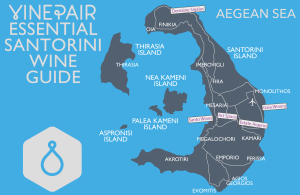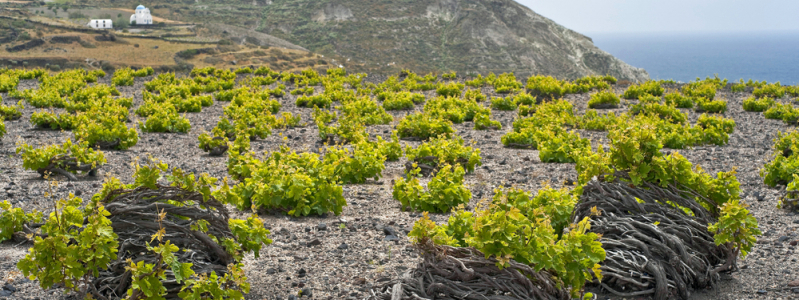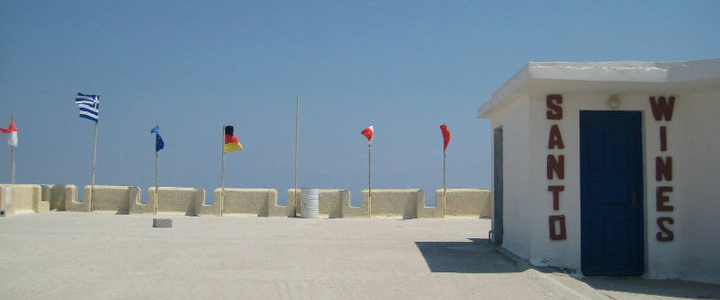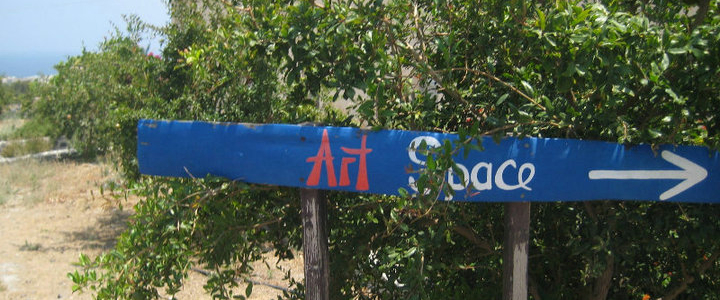
Standing on the cliffs looking out over the famed Santorini Caldera, one can’t be blamed for assuming this breathtaking view is the main thing this tiny little Grecian island should be known for. But in fact, in recent years, it’s not just the view, but the island’s wine that has made a name for itself outside of the Mediterranean, and that name is well deserved.
Santorini’s Assyrtiko, the white wine for which the island has become known, is the island’s essence in a bottle. A sip of the wine delivers a bracingly refreshing punch of citrus and the aromas that waft from its surface smell of the sea and the cliffs that surround the water. You can be transported to this island paradise with each bottle you open, and thanks to the fact that these wines are still under the radar, the best ones can be found for around twenty bucks — definitely much cheaper than a plane ticket!

While Assyrtiko from Santorini may seem like a new wine to most, the origin of Santorini’s wine culture goes back to ancient times. During the rule of the Venetians between the fourteenth and sixteenth century, Santorini was even producing some of the most valuable wine in all of Europe. And then, like all things, the Assyrtiko went out of style and Santorini wine fell off the map for a couple hundred years, with the island’s neighbors in Italy, France and Spain taking all the credit for fantastic wine.
Then in the twentieth century, Greek wine began to emerge on the American market as immigrants began coming to the US, with many opening restaurants and diners across the country. But the wine many of them brought along with them to the US wasn’t a wine for which the country should be known, because that wine was retsina, a traditional wine flavored with pine resin, delicious to some, but repulsive to many. Suffice it to say, this was a wine that could only appeal to a particular taste, which resulted in many labeling all Greek wine as bad, yet all the while Santorini’s vineyards continued to grow their Assyrtiko grapes and produce great juice.
One of the most amazing things to notice when you visit a winery in Santorini is the way the vines grow. Unlike the majority of vineyards around the world, where the vines grow in rows along trellises, in Santorini, the vines grow in tight bunches, packed close to the earth along the rocks, as if seeking as much shelter as they can get from the strong gusts of sea air. It is this sea air, along with the soil that is rich in volcanic ash, that imparts the refreshing acidity for which the wine has become so well known. Many believe it is this volcanic ash that allows the grapes grown on Santorini to retain their acidity, even when they are fully ripe, about to burst open with sugary juice.
Over the past few years, Assyrtiko has become easier to find on the US market, allowing most of us the ability to take a trip to the island without the eleven hour flight. But with July and August being the prime time for honeymoon season, and Santorini being a top destination, one can’t be blamed for considering a trip to the island instead, and it has the benefit of including a trip to wine country, all in one visit. With the island being as small as it is, one day is really all that’s needed to visit the island’s top wineries.
Whether you plan to visit the island in person, or visit it via a bottle of its wine, here are the wineries from Santorini you should be looking for:
Estate Argryos
The family that owns Estate Argryos has been producing wine on the island for over a century, and that history can be seen with every sip of their wine. A visit to the vineyard means a stop in the winery’s tiny tasting room, which at the time of our last visit was also functioning as the space where Matthew, the family’s 4th generation winemaker, also blends the wines. Even though the wines of Estate Agryos can now be found across the US, a tasting experience here will leave you feeling as if each wine they create is being produced solely for the people on the island.
Santo Wines
The largest winery on the island, Santo Wines is a cooperative winery that is made up of 2,500 growers who all deliver their grape harvests, no matter how large or small, to the winery each fall, which are then made into the many wines they create. Along with being the largest in terms of members, it is also the largest phyically. This plus the winery’s proximity to the harbor means the middle of the day can mean a ton of tour buses from the cruise ships, so we recommend making this your first or last stop of the day. The last stop is worth it, as their large balcony makes this a perfect place for viewing the sunset.
Domaine Sigalas
At only about twenty years old, Domaine Segalas is one of the younger wineries on the island, yet they are already winning acclaim internationally. Of all of these wines, probably the most celebrated is Sigalas’s oak barrel feremented Assyrtiko, which makes this vineyard worth the trip for that wine alone.
Gaia
You can’t really beat a winery built directly on the beach, which is exactly where you’ll find Gaia. This winery is also quite young for an island with such a rich history of wine production, but they have built a name for themselves not only as one of the island’s top producers, but also as one of their most experimental due to their wild fermented Assyrtiko. Wild fermented wine means that instead of physically adding yeast to the juice in order to begin the fermentation process, they instead allow the yeast that occurs naturally in the environment to enter into the mixture and ferment the wine, making every batch of the wine somewhat different.
Art Space Winery
Art Space Winery also functions as the island’s wine museum and is an ideal place to learn how wine has been made on the island for decades. In addition to making Assyrtiko, Art Space also makes Vinsanto, a sweet dessert wine that is created by drying out the freshly picked grapes on the roof of the vineyard, allowing them to prune and then juicing them, resulting in a highly sugary elixir that ferments to create a delicious syrupy treat, perfect for ending a meal.
Image of Santorini and of the vineyards via Shutterstock.com



